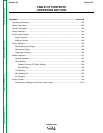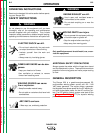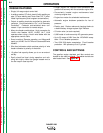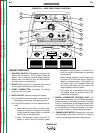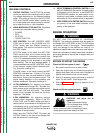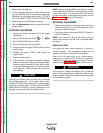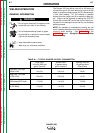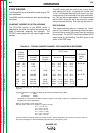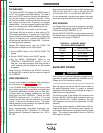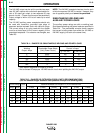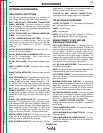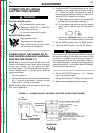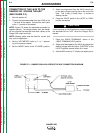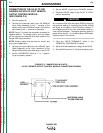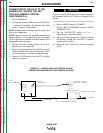
TIG WELDING
The TOUCH START TIG setting of the MODE switch is
for DC TIG (Tungsten Inert Gas) welding. To initiate a
weld, the OUTPUT control is first set to the desired cur-
rent and the tungsten is touched to the work. During
the time the tungsten is touching the work there is very
little voltage or current and, in general, no tungsten
contamination. Then the tungsten is gently lifted off the
work in a rocking motion, which establishes the arc.
The ARC CONTROL is not active in the TIG mode.
The Ranger 250 can be used in a wide variety of DC
TIG welding applications. In general the “Touch Start”
feature allows contamination-free starting without the
use of a Hi-frequency unit. If desired, the K930-2 TIG
Module can be used with the Ranger 250. The follow-
ing settings are for reference.
Ranger 250 settings when using the K930-2 TIG
Module with an Amptrol or Arc Start Switch:
a. Set the MODE Switch to the TOUCH START TIG
setting.
b. Set the “IDLER” Switch to the “AUTO” position.
c. Set the "WELD TERMINALS” switch to the
“REMOTELY CONTROLLED” position. This will
keep the solid state contactor open and provide a
“cold” electrode until the Amptrol or Arc Start switch
is pressed.
When using the TIG Module, the OUTPUT control on
the Ranger 250 is used to set the maximum range of
the CURRENT.
WIRE WELDING-CV
Connect a wire feeder to the Ranger 250 according to
the instructions in the Accessories section.
In the CV-WIRE mode, the Ranger 250 can be used
with a broad range of flux cored wire (Innershield and
Outershield) electrodes and solid wires for MIG weld-
ing (gas metal arc welding). Welding can be finely
tuned using the ARC CONTROL. Turning the ARC
CONTROL clockwise from -10 (soft) to +10 (crisp)
changes the arc from soft and washed-in to crisp and
narrow. It acts as an inductance control. The proper
setting depends on the procedure and operator prefer-
ence. Start with the dial set at 0.
Some recommended Innershield electrodes are:
NR-311, NS-3M, NR-207, NR-203 Ni 1%, NR-204-H.
Recommended Outershield electrodes are: 0S-70,
0S-71M.
Some recommended solid wires for MIG welding are:
.035 (0.9 mm), and .045 (1.1 mm), L-50 and L-56, .035
(0.9 mm) and .045 (1.1 mm) Blue Max MIG 308 LS.
For any electrodes, including those above, the proce-
dures should be kept within the rating of the machine.
ARC GOUGING
The Ranger 250 can be used for limited arc gouging.
For optimal performance, set the MODE switch to CC-
STICK and the ARC CONTROL to +10.
Set the OUTPUT CONTROL to adjust output current to
the desired level for the gouging electrode being used
according to the ratings in Table B.3.
TABLE B.3 – CURRENT RANGE
PER ELECTRODE DIAMETER
Electrode Current Range
Diameter (DC, Electrode Positive)
1/8" 30-60 Amps
5/32" 90-150 Amps
3/16" 150-200 Amps
AUXILIARY POWER
Be sure that any electrical equipment plugged into the
generator AC power receptacles can withstand a ±10%
voltage and a ±3% frequency variation.
Start the engine and set the IDLER control switch to
the desired operating mode. Full power is available
regardless of the welding control settings as long as no
welding current is being drawn.
The auxiliary power of the Ranger 250 consists of two
20 amp-120 VAC (5-20R) duplex receptacles and one
50 amp 120/240 VAC (14-50R) receptacle. The 240
VAC receptacle can be split for single-phase 120 VAC
operation.
The auxiliary power capacity is 8,000 watts of 60 Hz,
single-phase power. The auxiliary power capacity rat-
ing in watts is equivalent to volt-amperes at unity power
factor. The maximum permissible current of the 240
VAC output is 33 amps.
OPERATION
B-9 B-9
RANGER 250
Return to Section TOC Return to Section TOC Return to Section TOC Return to Section TOC
Return to Master TOC Return to Master TOC Return to Master TOC Return to Master TOC
WARNING



